Overview
The article examines ten pivotal ways in which artificial intelligence (AI) significantly enhances zoning analysis for title research directors. By focusing on automation, improved data processing, and real-time insights, it underscores the importance of accurate title research in today's complex regulatory landscape. AI tools streamline intricate regulatory processes, thereby reducing decision-making times and bolstering compliance accuracy.
Furthermore, these advancements culminate in more efficient workflows and better-informed property development decisions. The integration of AI not only addresses existing challenges but also paves the way for a more effective approach to zoning analysis, ultimately transforming the decision-making landscape for title research directors.
Introduction
The integration of artificial intelligence into zoning analysis is fundamentally reshaping the landscape of title research, delivering unparalleled efficiency and accuracy. As property directors confront the complexities inherent in land use regulations, AI tools have emerged as indispensable resources that not only streamline processes but also significantly enhance decision-making capabilities. However, with the rapid evolution of these technologies, the pressing question remains: how can title research directors effectively harness AI to navigate the challenges of zoning analysis while maximizing their return on investment?
Parse AI: Automate Title Research and Document Processing
Parse AI harnesses advanced machine learning and optical character recognition (OCR) technologies, which have significantly evolved since their inception, to enhance the extraction of vital information from document titles.
Historically, OCR technology has progressed from basic text recognition systems to sophisticated AI-driven solutions that comprehend context and meaning. This automation not only accelerates property investigations but also enhances precision, facilitating quicker real estate transactions and lowering operational costs.
Furthermore, industry insights indicate that companies adopting advanced OCR capabilities can secure considerable competitive advantages through heightened efficiency and reduced expenses. By incorporating Parse AI into their workflows, project directors can transition from laborious manual processing to strategic, high-level analysis, ultimately driving enhanced efficiency and effectiveness in their operations.
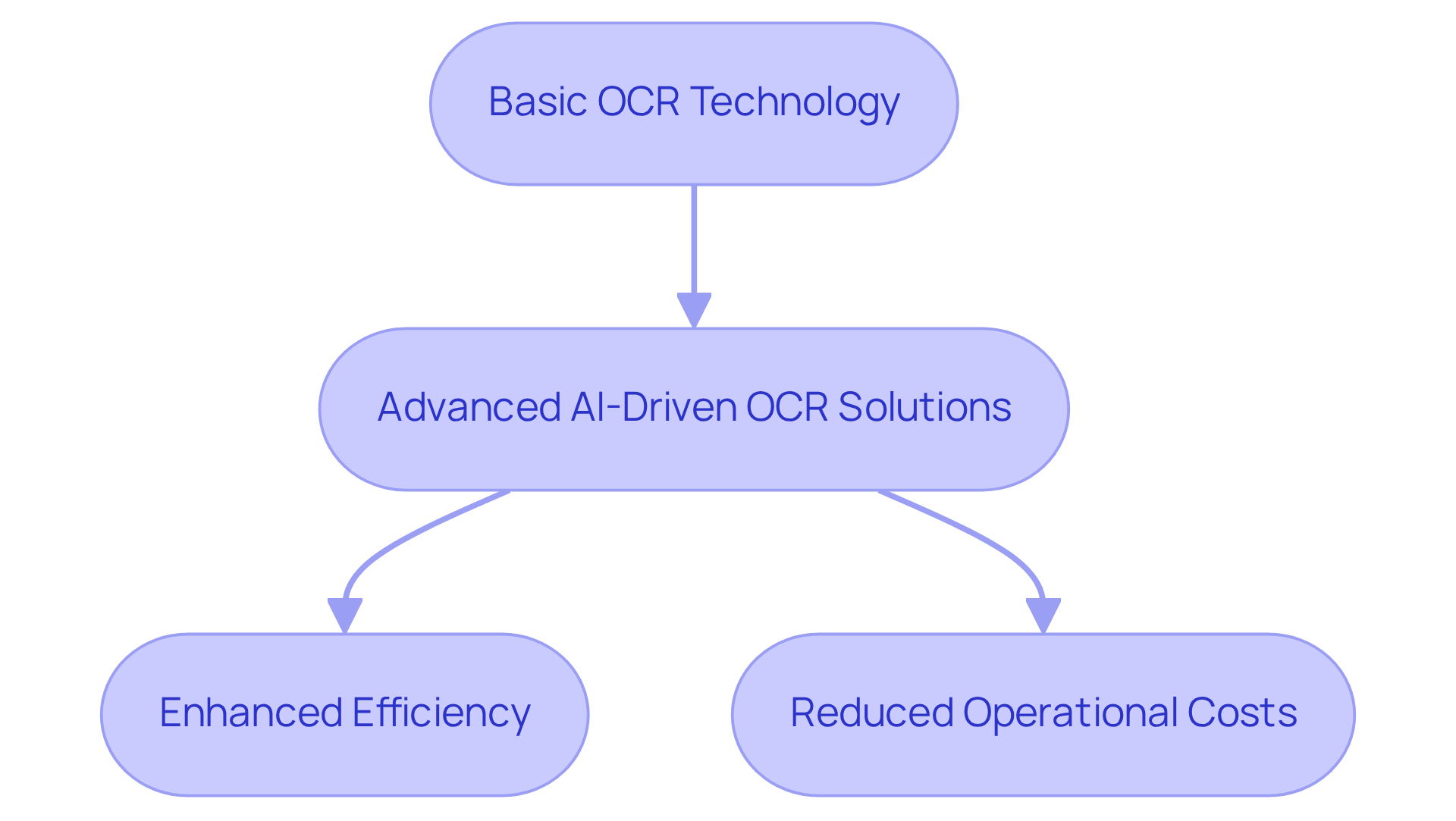
AI Zoning Analysis: Accelerate Research and Improve ROI
AI analysis tools are revolutionizing the management of large datasets, significantly reducing the time required for human researchers. By automating the analysis of land use regulations and property applications, these tools showcase how AI helps in zoning analysis, empowering property examination directors to make swift, informed decisions. This acceleration not only enhances operational efficiency but also boosts ROI by facilitating quicker project approvals and minimizing holding costs.
For instance, Lease End's implementation of AI agents has led to a remarkable 30% reduction in decision times, demonstrating how AI helps in zoning analysis by integrating AI into land use analysis. As industry leaders note, the transformation in property studies is due to how AI helps in zoning analysis by streamlining complex processes, making it an indispensable resource for legal professionals in 2025 and beyond.
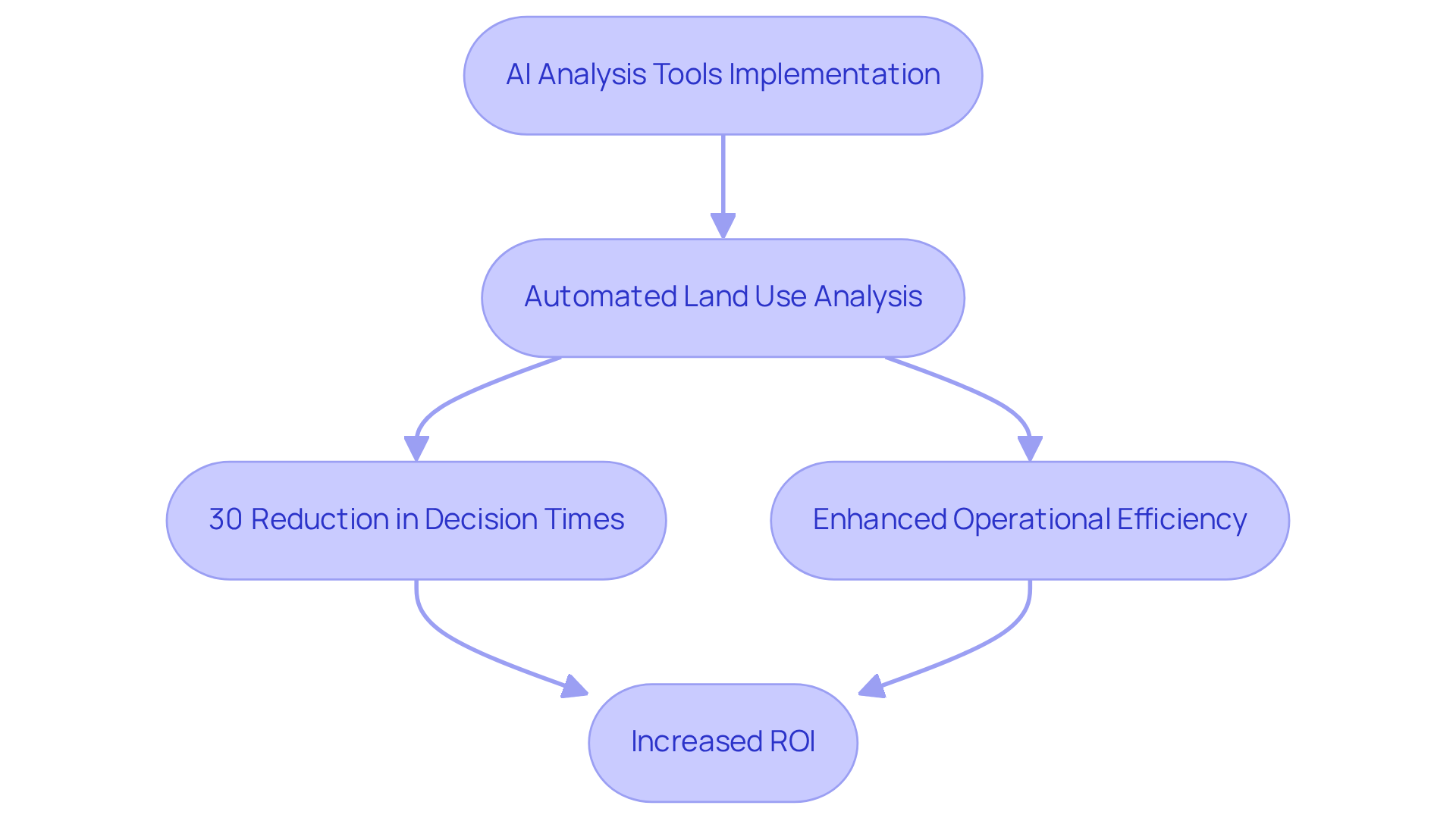
Atria AI: Simplify Zoning Regulations Understanding
Atria AI provides a robust platform designed to streamline the comprehension of regulatory guidelines by translating complex legal terminology into clear, actionable insights. This tool is particularly beneficial for directors tasked with ensuring compliance with local land use regulations. By leveraging Atria AI, professionals can efficiently assess land use regulations, showcasing how AI helps in zoning analysis and enabling them to make well-informed decisions regarding property development and utilization.
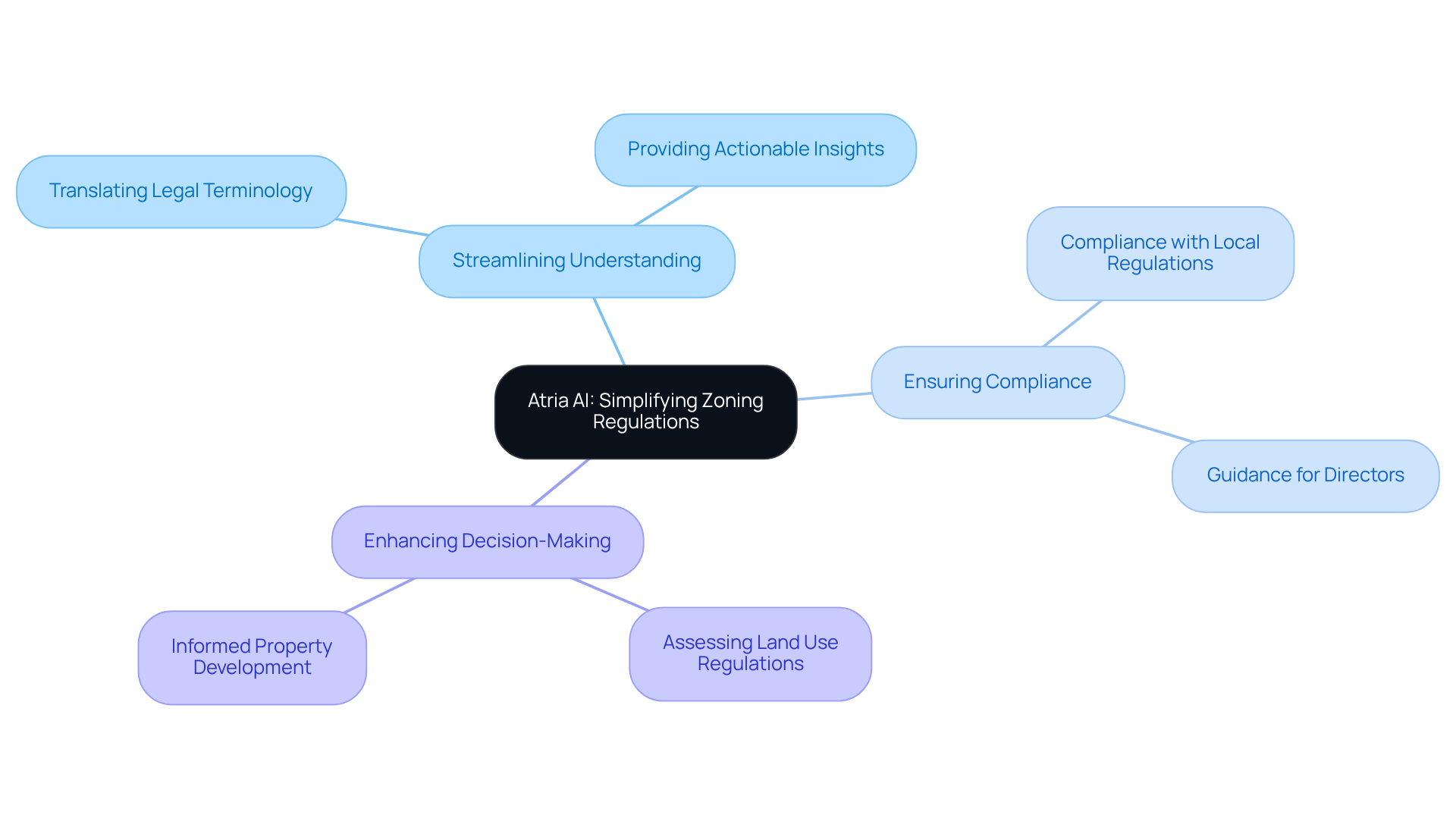
Canopy Mapping: Interactive Zoning Maps and Automated Reports
Canopy Mapping provides interactive land use maps that empower title directors to accurately visualize regulations and property lines. These maps seamlessly integrate automated reporting capabilities, delivering real-time updates on land use changes and regulatory requirements. By utilizing Canopy Mapping, professionals can significantly enhance their analysis and reporting capabilities, leading to more informed decision-making. The automation of land use reports streamlines the investigation process, facilitating faster evaluations of compliance and development opportunities—essential in today's fast-paced real estate environment.
AI tools enhance the efficiency of compliance checks for real estate properties, illustrating how AI helps in zoning analysis by simplifying processes and identifying potential issues early. As industry experts emphasize, "The efficiency gained through automated allocation reports not only saves time but also reduces the risk of errors, ensuring that title research directors can focus on strategic decision-making rather than manual data compilation." Furthermore, AI planning tools demonstrate how AI helps in zoning analysis by assessing building height limits, setbacks, and Floor Area Ratio (FAR) in mere seconds, illustrating the speed and efficiency achieved through automation.
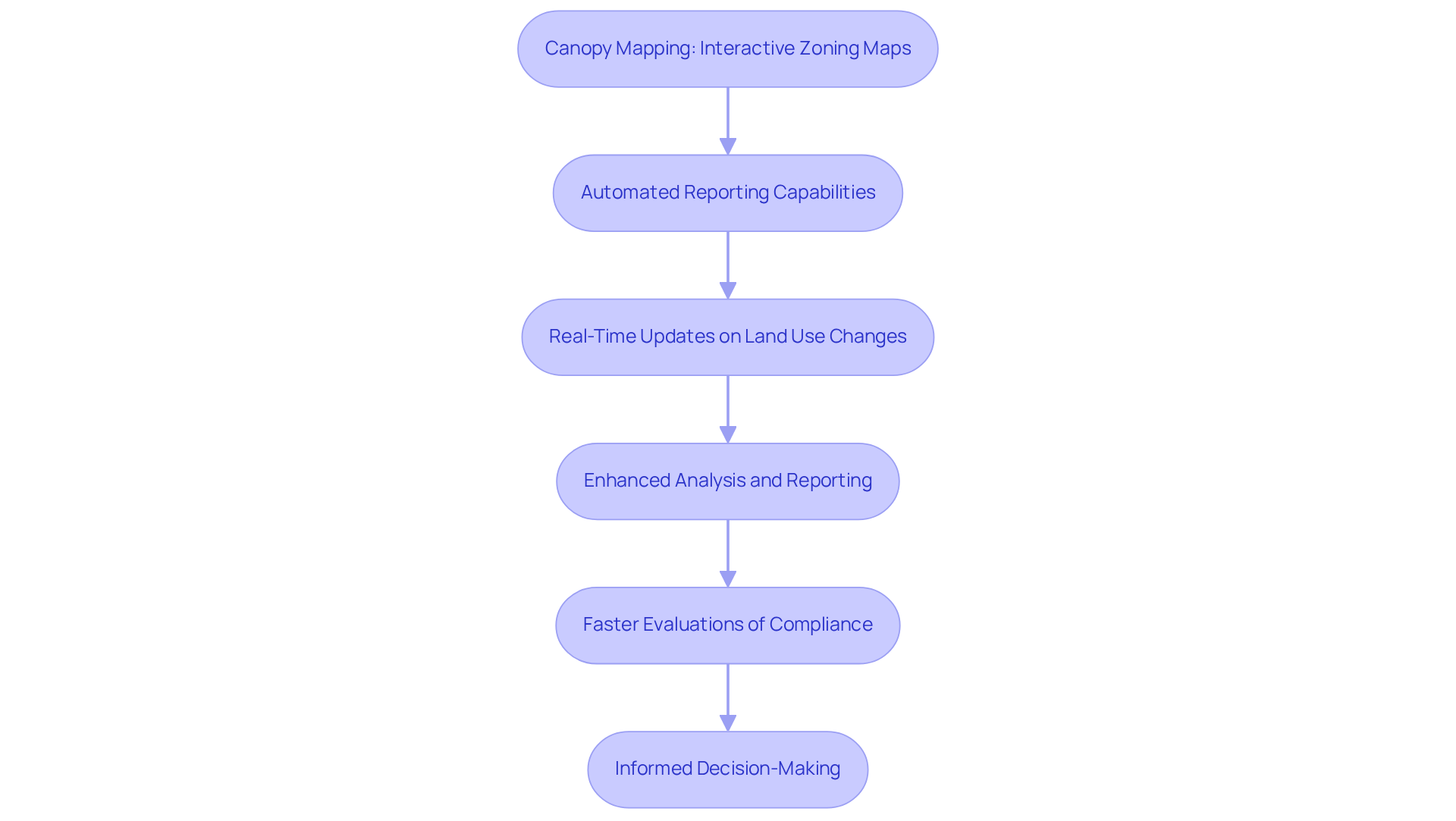
Datagrid AI: Streamline Zoning Permit Analysis and Compliance
Datagrid AI demonstrates how AI helps in zoning analysis by swiftly interpreting zoning codes, environmental regulations, and building standards. This advanced automation not only detects regulatory issues early but also enables documentation directors to proactively address potential challenges. By streamlining the permit analysis process, Datagrid AI shows how AI helps in zoning analysis by significantly reducing the time required for reviews, allowing projects to stay on schedule and adhere to regulatory requirements.
For instance, municipalities that have adopted AI solutions report a reduction in review cycles and fewer resubmittals, enhancing overall efficiency. As one title research director noted, 'Accurate, timely processing reduces backlogs that drain staff budgets and keeps your capital-improvement timeline aligned with the master plan.' Furthermore, the integration of automated compliance checks ensures that all necessary documentation is in order, minimizing the risk of delays caused by missing or outdated information.
This proactive approach not only fosters a smoother workflow but also builds trust within the community by ensuring that all projects meet the required standards before approval.
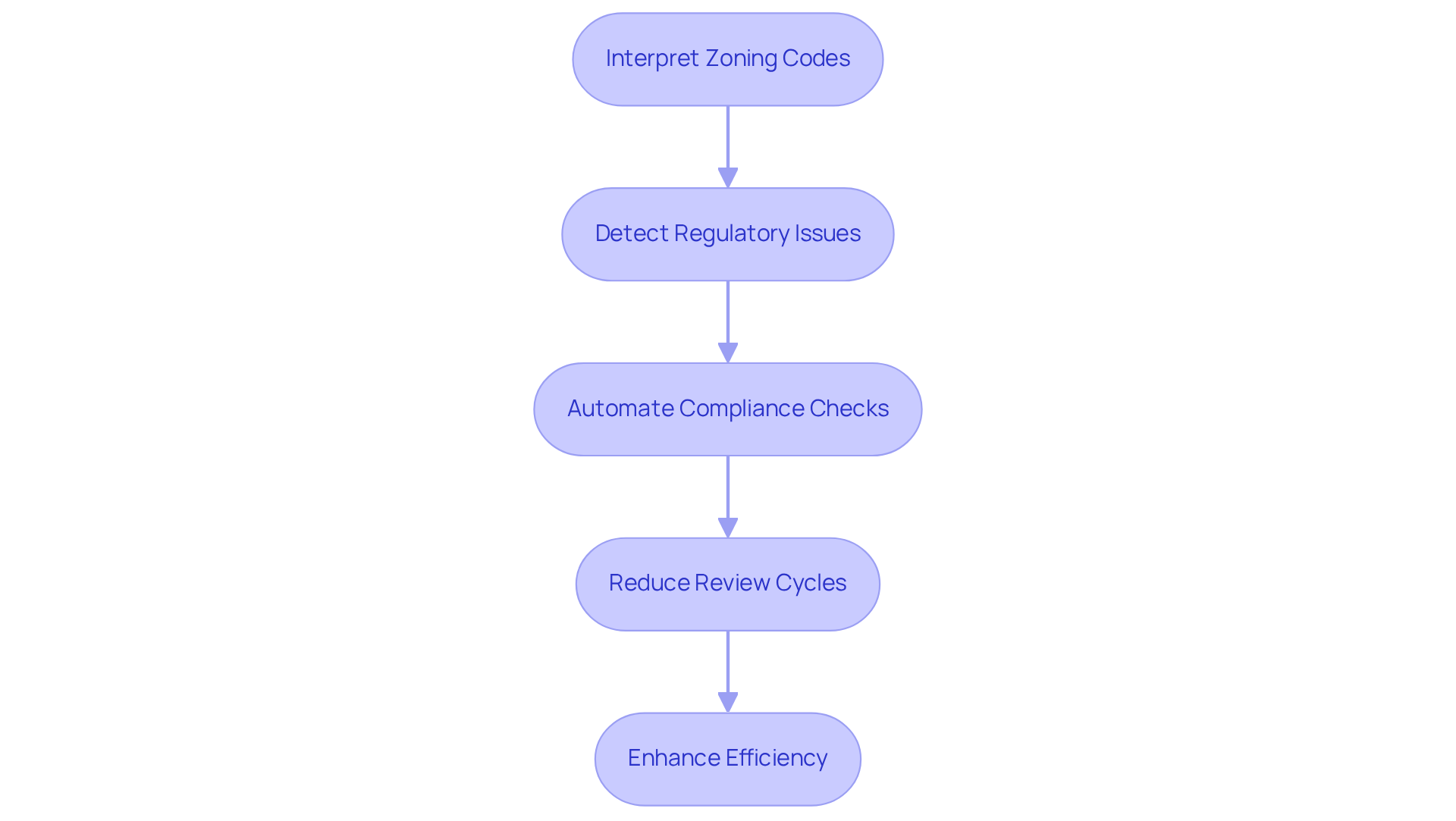
Urban AI: Generative AI for Zoning Acquisition
Urban AI harnesses the power of generative AI to transform land use acquisition processes by simulating various development scenarios and forecasting outcomes based on existing land use regulations. This innovative capability empowers property acquisition directors to evaluate multiple options, thus facilitating data-driven decisions that significantly enhance property acquisition strategies. By leveraging Urban AI, professionals can refine their planning approaches, resulting in higher project success rates. Indeed, organizations that integrate AI into their decision-making processes have reported a 40% improvement in work quality, as highlighted in a Harvard Business School study. This underscores the effectiveness of data-driven strategies in the real estate sector.
As property management directors face challenges related to the time and resources required to verify real estate ownership, they must recognize how AI helps in zoning analysis to maintain a competitive edge in land use analysis and property development. As Greg Goodman, Group CEO, remarked, 'Significant growth in data storage, and AI in particular, is driving data center demand, which is now approximately 30% of our $13 billion development workbook.' This statement emphasizes the pivotal role of AI in enhancing decision-making processes within the real estate industry.
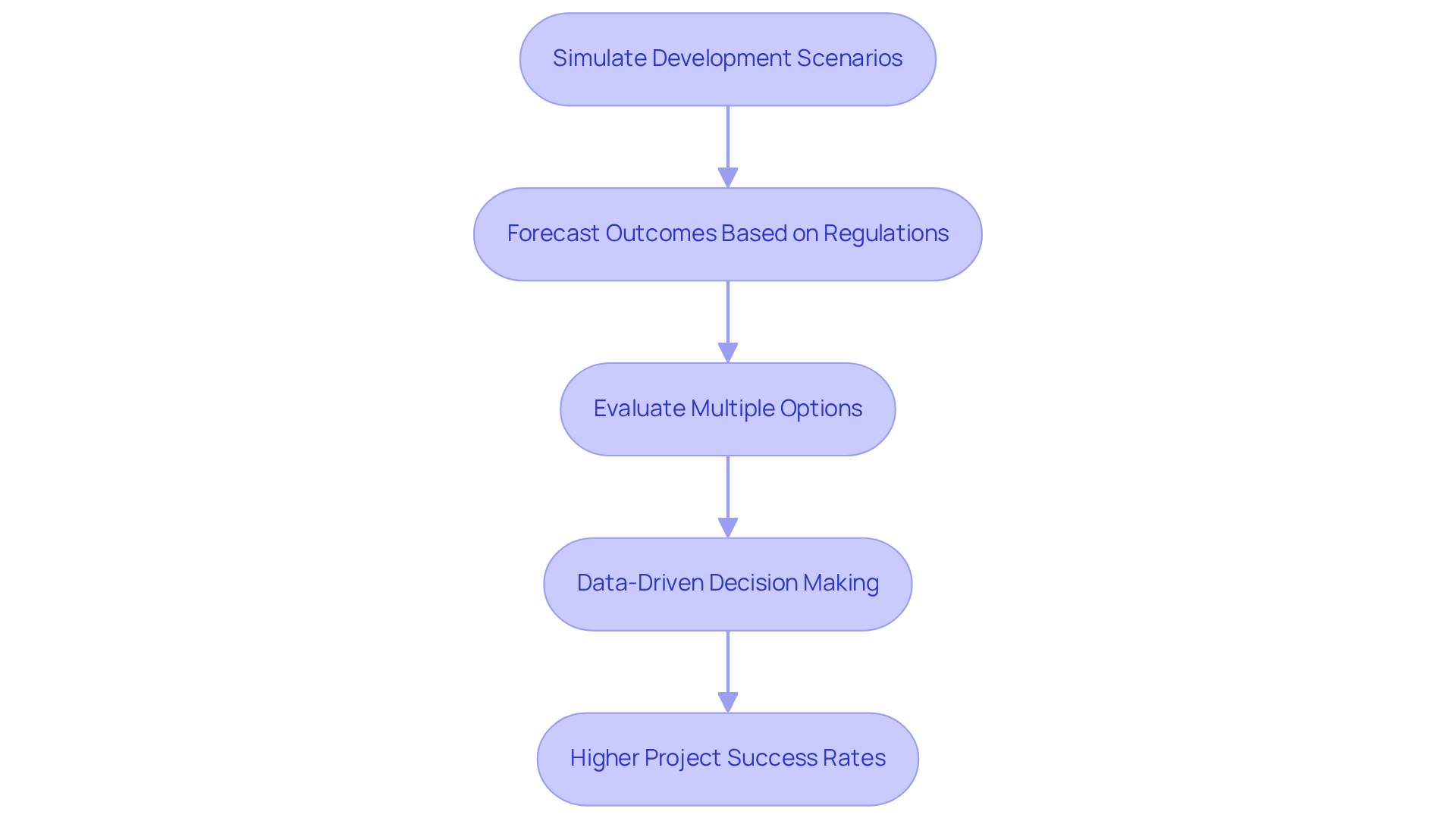
Plotzy AI: Automate Code Interpretation for Zoning
Plotzy AI transforms the understanding of intricate land use regulations, enabling title specialists to swiftly grasp allowed uses, density restrictions, and other essential elements. By automating this complex process, Plotzy AI significantly reduces the time traditionally spent on manual code interpretation, resulting in efficiency gains that are vital in today’s fast-paced real estate environment. Notably, how AI helps in zoning analysis has been shown to decrease errors by up to 49%, thereby minimizing the risk of compliance issues that may arise from human oversight.
Furthermore, AI tools like Plotzy are projected to generate between $110 billion and $180 billion in value for real estate professionals, underscoring their critical role in the industry. As Christopher A. Watson, Director of Planning and Development Services at Murphy Schiller & Wilkes LLP, articulated, "AI enhances planning by modeling future spaces and analyzing costs with speed and precision."
Looking ahead to 2025, the continued use of AI tools like Plotzy is expected to further revolutionize land use studies, illustrating how AI helps in zoning analysis by enhancing their reliability and efficiency like never before, despite challenges such as inconsistent land use data across jurisdictions.
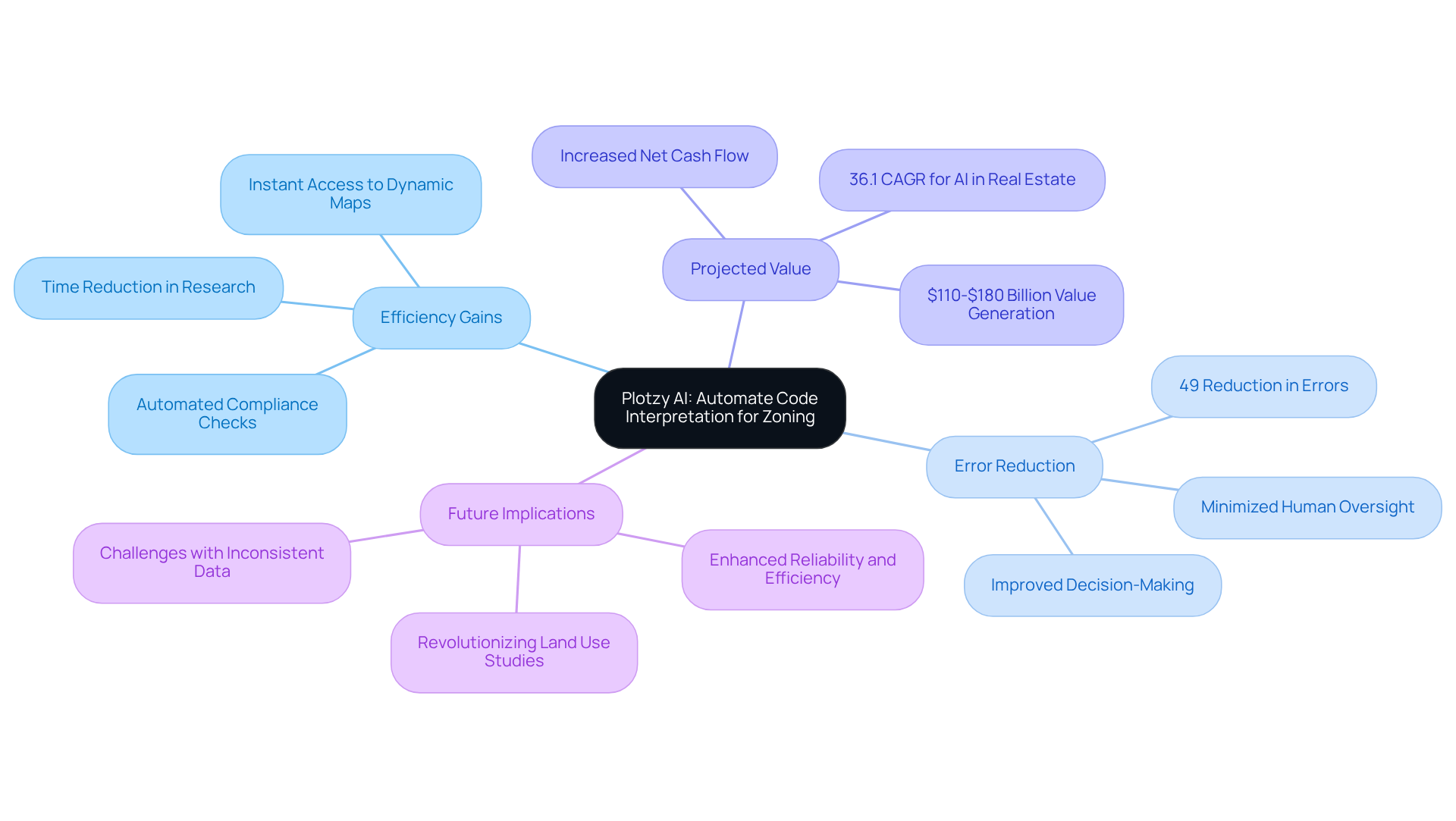
Zweig Group: AI-Powered Tools for Redefining Land Use
AI technology is revolutionizing land use planning by demonstrating how AI helps in zoning analysis through advanced tools that analyze current land use regulations and propose innovative solutions. As noted by experts, "AI is fundamentally transforming how we live by providing unprecedented tools and personalization into everyone’s hands" (Ahyoung An, MuleSoft). These AI-driven tools empower land use directors to efficiently assess how AI helps in zoning analysis regarding the potential impacts of land use changes, ensuring that decisions are informed and aligned with community objectives and sustainability initiatives. By integrating AI into their strategies, professionals can improve their land use planning processes, demonstrating how AI helps in zoning analysis and fostering a more efficient and responsive approach to urban development.
Furthermore, businesses must adopt a customer-centric approach when implementing AI, as "AI should be deployed with a customer-centric approach to drive growth and profitability" (Brett Wharton, NexusMKTG). Experts emphasize how AI helps in zoning analysis, as the future of land use planning will increasingly depend on creating smarter, more adaptable environments that meet the evolving needs of communities.
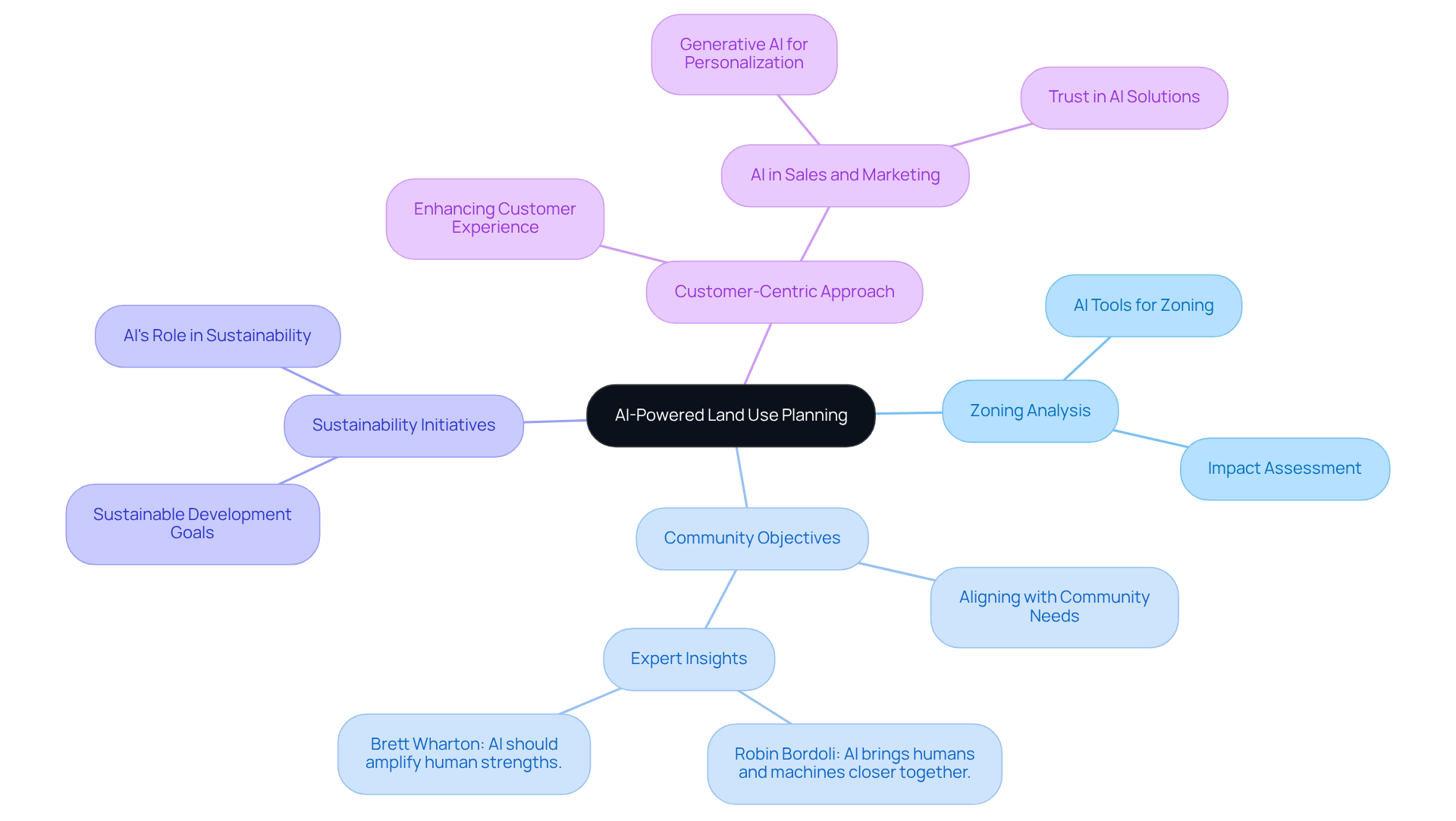
Reed Smith: Addressing Risks in Zoning Research with AI
Reed Smith effectively harnesses AI to recognize and address potential risks in area studies, notably inconsistencies in property ownership and regulatory issues. This innovative approach empowers title research directors to proactively manage regulatory risks, ensuring that their projects are in alignment with legal requirements.
Furthermore, this method enhances adherence efforts while simultaneously safeguarding against potential legal challenges stemming from land use disputes. As the landscape of land use regulations continues to evolve, the integration of AI tools is becoming increasingly essential, particularly in understanding how AI helps in zoning analysis to navigate the complexities of adherence in 2025 and beyond.
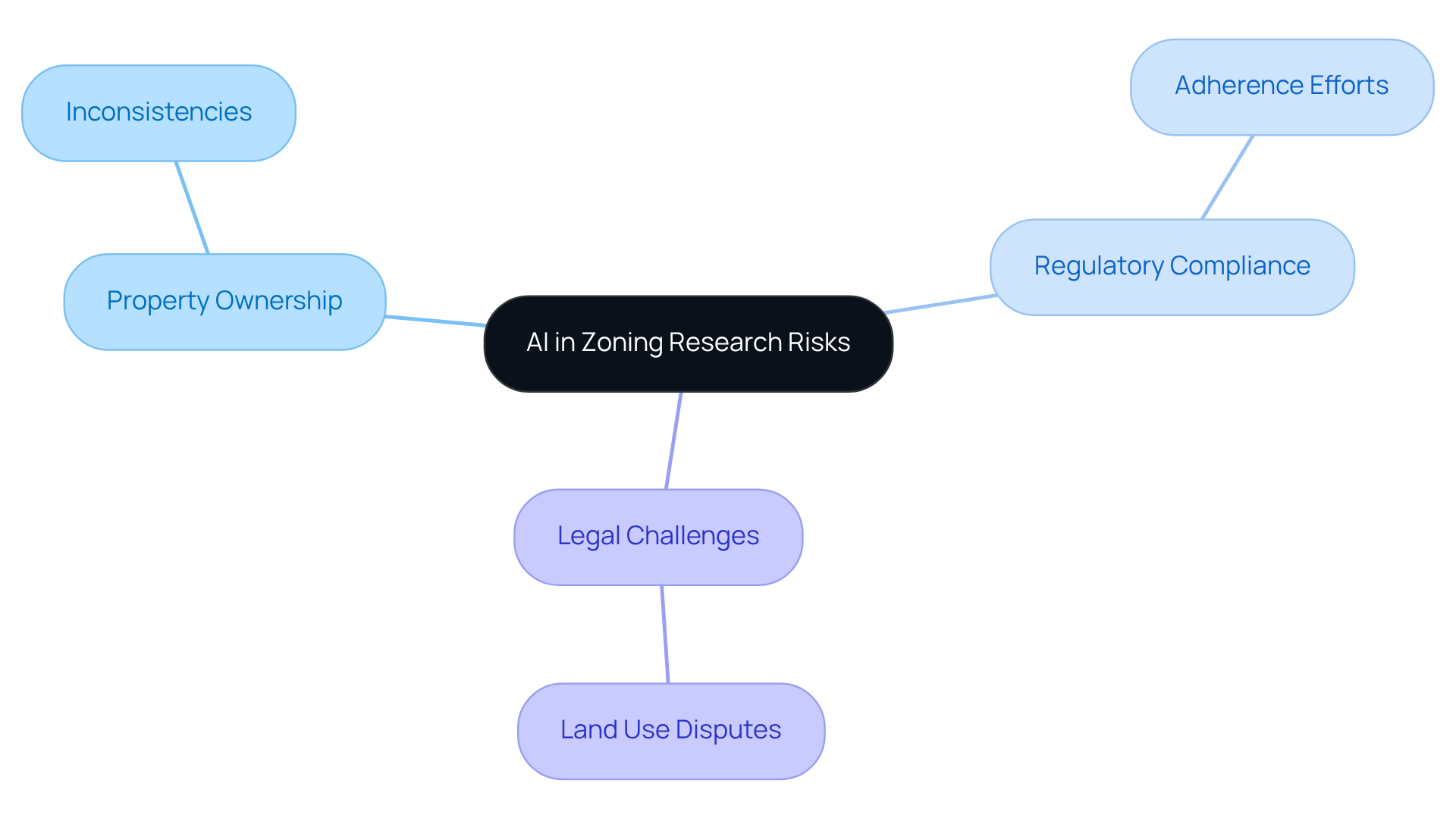
Ask Atria: Enhance Accuracy and Reliability in Zoning Analysis
Ask Atria significantly enhances the accuracy and reliability of area analysis by providing real-time data and insights. This platform equips title research directors with prompt access to the latest information on land use regulations and adherence requirements, ensuring their analyses are grounded in the most current data available. In 2025, the importance of real-time data in regulatory compliance is underscored by studies indicating that timely information can reduce compliance errors by as much as 30%. By improving the accuracy of land use analysis, Ask Atria showcases how AI helps in zoning analysis, empowering professionals to make informed decisions that not only meet regulatory standards but also align with community expectations.
Furthermore, industry leaders assert that reliable zoning information is essential for effective decision-making, reinforcing the value of platforms like Ask Atria in the ever-evolving landscape of title research.
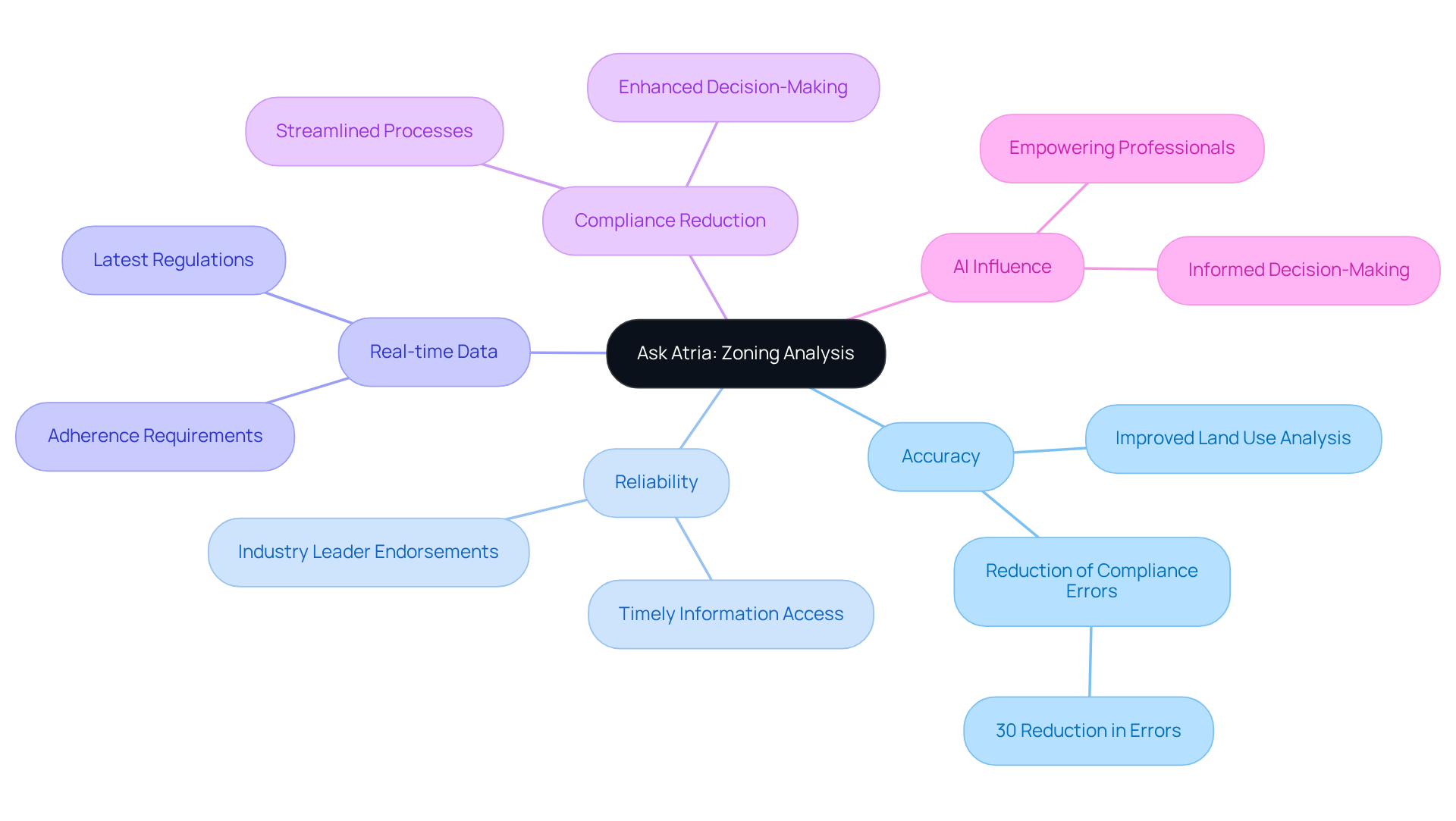
Conclusion
The integration of artificial intelligence into zoning analysis signifies a transformative advancement for title research directors, streamlining processes and enhancing decision-making capabilities. By automating tasks such as document processing, regulatory interpretation, and compliance checks, AI tools significantly reduce the time and effort required to manage complex datasets and ensure regulatory adherence.
Throughout this discussion, various AI applications illustrate their specific contributions to zoning analysis. From Parse AI's document automation to Atria AI's clarity in regulatory understanding, each tool offers unique benefits that collectively enhance operational efficiency and accuracy. Furthermore, the use of interactive mapping and generative AI underscores how these technologies can drive improved project outcomes and ROI by simplifying complex processes and enabling data-driven decisions.
As the landscape of real estate continues to evolve, the importance of leveraging AI in zoning analysis cannot be overstated. Embracing these innovative solutions is essential for professionals aiming to navigate the complexities of land use regulations effectively. By adopting AI-powered tools, title research directors position themselves to enhance their workflows, reduce risks, and ultimately contribute to more sustainable and community-aligned development practices. The future of zoning analysis is here, and it is powered by artificial intelligence.
Frequently Asked Questions
What technologies does Parse AI utilize to enhance document title research?
Parse AI harnesses advanced machine learning and optical character recognition (OCR) technologies to enhance the extraction of vital information from document titles.
How has OCR technology evolved over time?
OCR technology has progressed from basic text recognition systems to sophisticated AI-driven solutions that can comprehend context and meaning.
What are the benefits of using Parse AI in real estate transactions?
The automation provided by Parse AI accelerates property investigations, enhances precision, facilitates quicker real estate transactions, and lowers operational costs.
How can companies benefit from adopting advanced OCR capabilities?
Companies that adopt advanced OCR capabilities can secure considerable competitive advantages through heightened efficiency and reduced expenses.
What impact does AI zoning analysis have on property examination?
AI zoning analysis tools automate the analysis of land use regulations and property applications, significantly reducing the time required for human researchers to make informed decisions.
Can you provide an example of AI's impact on decision-making times in zoning analysis?
Lease End's implementation of AI agents has led to a remarkable 30% reduction in decision times, showcasing the efficiency gained through AI in zoning analysis.
How does Atria AI assist in understanding zoning regulations?
Atria AI streamlines the comprehension of regulatory guidelines by translating complex legal terminology into clear, actionable insights, helping professionals ensure compliance with local land use regulations.
Who benefits most from using Atria AI?
Directors tasked with ensuring compliance with local land use regulations benefit the most from Atria AI, as it enables them to make well-informed decisions regarding property development and utilization.




